The TBL-UDL-Engagement Trilogy in a General Chemistry Course
Published Jan 20, 2022 by
Introduction
Part of the challenge for engaging students in the learning process requires understanding how and why teaching methods designed to enhance engagement impact student learning. In this case study, the theoretical context of engagement and practical basis for the implementation of team-based learning (TBL) in a general chemistry course taught by Dr. Rosa Bell at East Carolina University are addressed. Students’ perceptions of engagement, instructional practices, and learning in the chemistry course are also discussed.
Objectives
After completing this case study, participants will ….
- Be familiar with the steps taken to implement team-based learning in a large-enrollment, freshman-level course.
- Identify possibilities for implementing team-based learning in their classrooms.
- Have the basic knowledge required for making a plan to incorporate Readiness Assurance Process (RAP) into their contexts.
- Gain insight into students’ perceptions about engagement, instructional guidance and learning in a team-based learning framework.
UDL Alignment
Each College STAR module/case study seeks to explain how a particular instructional practice described within the module aligns with one or more of the principles of UDL. The instructional practices used in team-based learning align with the Provide Multiple Means of Representation, Multiple Means of Engagement, and Multiple Means of Action or Expression principles.
Providing Multiple Means of Representation
The strategy called Readiness Assurance Process, which is considered the pillar of team-based learning, is used to hold students accountable for the quality and quantity of their individual and teamwork and to ensure that they came to class with the basic knowledge of core concepts. To assist students gaining the basic knowledge required to effectively participate in the team problem-solving activities that take place in the classroom, course material is made available in different formats: textbook readings, instructor-selected YouTube videos, and the PowerPoint lecture slides. Learning is a personal experience; different learners approach the same learning task in different ways and process information in their own way. Presenting course information in more than one format provides learners the flexibility of accessing the course material in whichever venue is best suited to the learning preferences. Some learners process information better by watching a video clip. Others prefer reading and writing, and many acquire new knowledge best by using a combination of ways for accessing course material.
Providing Multiple Means of Engagement
The team-based learning approach provides students with multiple opportunities to engage in the learning process. The first opportunity happens when students study the material on their own outside the classroom prior to class sessions. Then, during the Readiness Assurance Process, students engage by working on pre-class preparation tests individually and in groups, through group discussions, making appeals of questions their team gets wrong, and receiving additional focused input from the instructor. Students have the opportunity to enhance their understanding of the course material during the team problem-solving activity.
Providing Multiple Means of Action or Expression
Team-based learning facilitates the development of leaner’s fluencies with graduated levels of support for practice and performance by providing scaffolds and many opportunities for demonstrating and expressing their understanding of the course material. For the pre-class preparation activity, students are provided with a list of guiding questions. At the beginning of each segment of new course material, students take, individually, a multiple-choice quiz on key concepts and foundational knowledge. After completing the quiz individually, students take the same quiz with their team members. Students in each team partake in discussions that foster not only a deeper understanding of the course material but also the development of communication skills and a sense of community. Additional opportunities for practice and performance is given through online homework assignments and formative and summative exams. The team-problem solving activity allows students to consider different approaches to solve a problem, compare their reasoning with that of the other classmates and to construct new ways of thinking.
Instructional Practice
Team-Based Learning (TBL)
Team-based learning (TBL) is an active learning strategy that promotes student engagement (Clark, Nguyen, Bray & Levine, 2008; Haidet, Morgan, O’Malley, Moran, & Richards, 2004; Prince, 2004), increases test performance (Koles, Stolfi, Borges, Nelson, & Parmelee, 2010), promotes positive student attitudes toward group work (Parmelee, DeStephen, & Borges, 2009), and develops professional competencies that are difficult to nurture or assess through lecture-based instruction (Beatty, Kelley, Metzger, Bellebaum, & McAuley, 2009; Parmelee and Michaelsen, 2010). Team-based learning is, moreover, an application-oriented pedagogical strategy (Thompson, Schneider, Haidet, Perkowski, & Richards, 2007) that is believed to promote high levels of active student participation by integrating small groups into a large class (Haidet & Fecile, 2006).
Fink (2002) defines team-based learning using two key ideas. One is that TBL involves the formation of social units that are quite different from “groups” in the sense that the social units are characterized by a high level of individual commitment to the welfare of the group and high levels of trust among the members of the group. The process by which a group of students becomes a “team” requires a) time for members to interact, b) scholarly resources, c) challenging tasks that become common goals, and d) frequent feedback on individual and group performance. A second key idea is that team-based learning is not simply a series of disconnected group activities, but a particular instructional strategy that often requires a complete course redesign. The restructuring of the course involves dividing the material into five to seven modules focused on the core topics of the subject.
Overview of the Structure of Team-Based Learning (TBL)
Figure 1 shows the sequence of learning activities that occur within a course module. The sequence of interdependent activities involved in the three phases of TBL offers students multiple opportunities for engaging in the learning process and for demonstrating and expressing their understanding of the course material. The first opportunity happens when students study the material on their own outside the class. Then, during the Readiness Assurance Process, students increase their understanding by working on pre-class preparation tests individually and in groups, through group discussions, making appeals of questions their team gets wrong, and receiving additional focused input from the instructor. Following the Readiness Assurance Process, students have the opportunity to enhance their understanding of the course material by applying their knowledge to solve problems with their teammates (Michaelsen, L. K.; Knight, L. B.; and Fink, L. D., 2002).
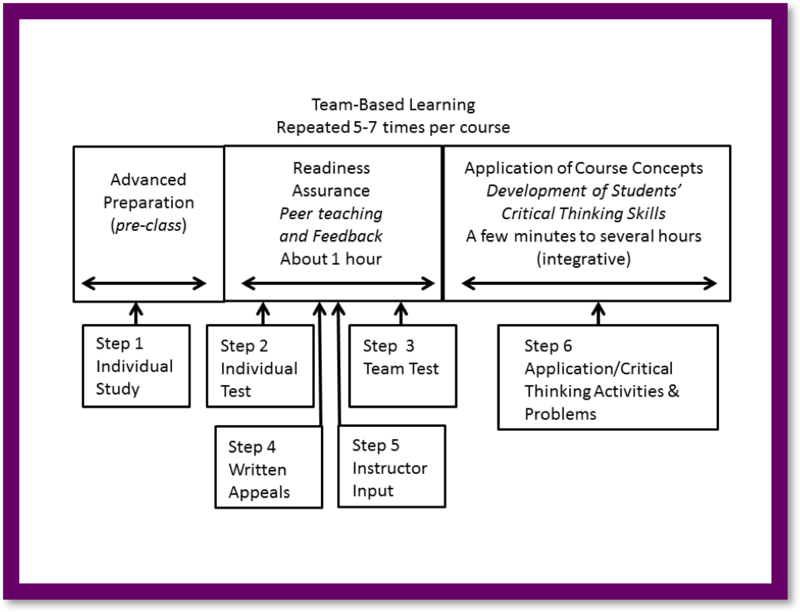
Figure 1: Instructional Activity Sequence for TBL a module
(Source: Parmelee, D. X. and Michaelsen, L. K. (2010). Twelve tips for doing effective Team-Based Learning (TBL). Medical Teacher. 32, p. 119)
Implementation of team-based learning in Dr. Bell’s General Chemistry II course involved a complete course redesign. She divides the course material into the six modules listed in table 1 and her class into small permanent teams of 8 members. Each team is designated a color which corresponds to the colors on the seating map shown in figure 2 below. On the first day of classes, the map is displayed on large screens, and students spend some time finding their seats and their teammates.
| Module | Topics |
| 1 | Intermolecular Forces, Liquids, and Solids, Solutions |
| 2 | Chemical Kinetics and Chemical Equilibrium |
| 3 | Acids and Bases |
| 4 | Aqueous Ionic Equilibrium |
| 5 | Thermodynamics and Electrochemistry |
| 6 | Radioactivity and Nuclear Chemistry |
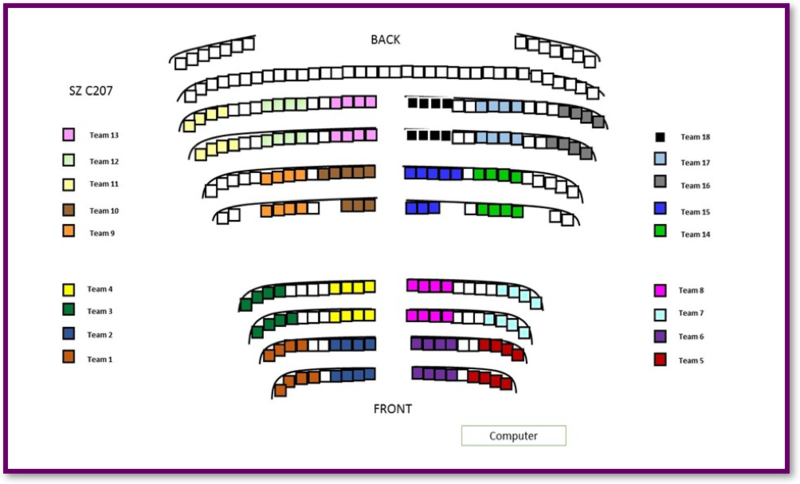
Figure 2: Organization of small permanent teams in the classroom
Considering that many students have difficulties comprehending the specialized vocabulary and syntax characteristic of science textbooks (Zwaan & Singer, 2003), in order to make the assignments manageable for the students, Dr. Bell compartmentalized each module into small “chunks” of course material and applied the sequence of activities depicted in figure 1 to each “chunk” of course content.
Introducing Team-Based Learning (TBL) to Students Prior to the First Day of Classes.
Most students taking General Chemistry II have never had a team-based learning classroom experience in a setting in which they are responsible for first exposure to the course content. To introduce them to this instructional strategy, Dr. Bell reaches out to students, via email, prior to the first day of classes. On her email (figure 3 below), she attaches a document describing the Readiness Assurance Process and the expectations associated with it. Additionally, Dr. Bell spends a significant amount of time during the first class meeting addressing students’ questions regarding team-based learning.
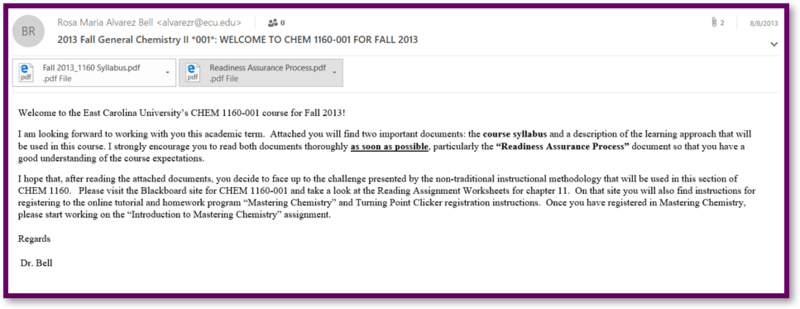
Figure 3: Email introducing TBL to students
Structure of TBL as Implemented in General Chemistry II course
Phase 1: Advanced (Pre-Class) Preparation
For the team-based learning instructional approach to be effective, students need to come to class with some basic knowledge of the course material (Michaelsen and Sweet, 2008). Dr. Bell makes available, through Blackboard (a Learning Management System), multiple means to assist students gaining the basic knowledge required to effectively engage in the class activities: readings guides, links to instructor-selected YouTube videos, and PowerPoint lecture slides.
The reading guides consist of a series of questions aimed to promote reflection while reading. Figure 4 (below) shows a section of the reading guide for the first “chunk” of course content corresponding to module 1. The guide specifies the textbook sections that are to be read, and it is used as scaffold for executive function expansion as it helps learners manage information and keep it organized. Students may choose to complete the guide by handwriting the answers to the questions in the spaces provided or using word processing software. They are encouraged to bring a hard copy or an electronic copy of the completed guide to class. Different students navigate a learning environment and express what they know in different ways. Providing alternatives for physically interacting with the course material affords students the flexibility to use whichever format they prefer and allows them to successfully demonstrate their knowledge.
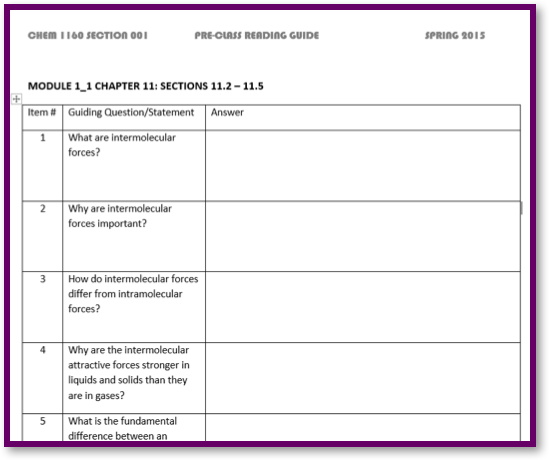
Figure 4: Pre-class reading guide for module 1-1 (Intermolecular Forces)
As suggested by the student’s comment below, the pre-class preparation assignments help students to stay on track and engage with the course material consistently during the academic term.
The strengths of this course were the team-based learning, I feel it is superior to normal lectures and I have to come prepared to each class which makes me stay on top of the information the entire course.
Phase 2: Readiness Assurance Process
The goal of the readiness assurance process is to make sure that students attain the theoretical background knowledge necessary to engage in the problem-solving exercises. The process consists of four steps: individual test, team test, appeals, and instructor input.
Individual Readiness Assurance Test (iRTA)
The readiness assurance process for each small “chunk” of course material begins with a closed-book individual test. The test consists of multiple-choice questions on key concepts and foundational knowledge. Questions are displayed, one at a time, on large screens and students are allowed one minute to read and answer each question using their clickers (figure 5 below). After the polling time for each question is over, a graph bar with the distribution of responses is displayed on the screens, but the correct answer is not shown at that moment. The immediate feedback provided by this feature of clicker technology allows Dr. Bell and her students to gauge their level of understanding of the material read and helps with identifying what questions require in-depth discussion during the next stage of the readiness assurance process: the team test.
Due to its visual-motor integration demand, the clicker-response testing format proved to be challenging for several students; particularly, for those with lower reading fluency and slower information processing speed. To reduce the barriers introduced by the clicker-response format, Dr. Bell switched to a different format using Blackboard Ô, an online platform for teaching and learning. She makes the individual readiness assurance tests (iRAts) available on Blackboard two days before the deadline for completion and students can take the test up to three times. The online individual readiness assurance tests format allows students to complete the task, within the test availability time window, at the time and place of their choosing. It also offers flexibility for navigating and responding to the test questions. Students can either use keyboard commands or mouse actions to submit their answers. The multiple-attempt feature of the online tests along with the immediate feedback provided by Blackboard, offers students an opportunity for revising their understanding of the concepts. If they do not answer a question correctly on their first attempt, they can review their notes/resources, reevaluate their reasoning and select another answer.
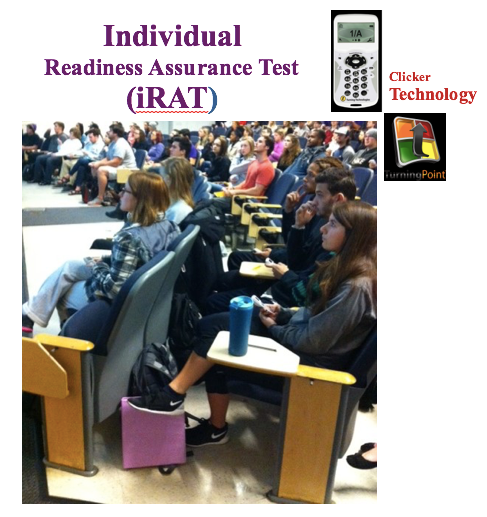
Figure 5: Administration of Individual Readiness Assurance Test (iRAT)
Team Readiness Assurance Test (tRAT)
After completing the test individually, students take the same quiz with their team members. For this part of the in-class activity, a manila envelope containing two hard copies of the test and an “Immediate Feedback Assessment Technique” (IF-AT) card (figure 6 below) is provided to each team. Five minutes before the session starts, Dr. Bell places the manila envelopes on a table at the front of the room. After the conclusion of the individual test, she instructs teams to send a representative to the front of the room to pick up their envelopes.
Teams prepare their IF-AT cards by writing down their team number (in the space provided for name), their course number and section (in the space provided for subject), and the date. On the back of the card, students write their names.

Figure 6: Administration of the Team Readiness Assurance Test (tRAT)
Each team designates a person to read the questions to the other members of the team. In order to reach consensus regarding the answers to the test questions, students in each team must engage in discussions and share their interpretations of the questions. These discussions foster not only a deeper understanding of the course material but also development of communication skills and a sense of community. During this phase of the in-class activity, students are encouraged to refer to their notes, books, or web-based resources.
Team answers are submitted on the assigned IF-AT card, which is a self-scoring answer sheet that has a thin opaque film covering the answer options. The card allows teams to check the accuracy of their answer choices as they are taking the test, correct their misconceptions and receive partial credit if they do not select the correct answer on their first attempt (Epstein, Lazarus, Calvano, Matthews, Hendel, Epstein, and Brosvic, 2002). In her General Chemistry II course, Dr. Bell assigns partial credit based on the point scale described in table 2 (below).
| Points | Correct answer found in |
| 5 | First try |
| 3 | Second try |
| 1 | Third try |
| 0 | Fourth try |
A member of each team is made responsible for scratching off the coating of the film on the rectangle corresponding to the team’s first-choice answer. If the selected answer is correct, a star is uncovered somewhere within the rectangle; the team receives full credit for their answer and moves on to the next question. If the selected answer is not correct, they continue discussing the question and subsequently select other choices until they reach the correct answer. By allowing partial credit for more than one attempt for determining the correct answer, this technique keeps students motivated to “read carefully, re-read and re-consider” each question.
The score for each question is recorded by the students in the column on the right of the card. After answering all the questions, a team member calculates the total number of points earned by the team, places the completed IF-AT card inside the team envelope, and takes it back to the table at the front of the room.
When fifty percent of the teams have submitted their completed IF-AT cards, Dr. Bell lets the remaining teams know that they have two more minutes to finish the test. While teams are submitting their scoring cards, Dr. Bell identifies the questions that required multiple attempts to reach the correct answer. This gives her a sense of the concepts that need to be clarified during the “instructor input” stage of the readiness assurance process.
Written Appeals
Following the team quiz, teams have the opportunity to appeal answers they get wrong due to ambiguity in the questions. Teams must provide evidence and create a convincing written argument as to why their answer is correct. Students must submit their written appeal to Dr. Bell no later than 5 minutes after the conclusion of the team test. Dr. Bell reviews the appeal outside the classroom and returns a response to the team by the following class period.
Instructor Input
Based on the immediate feedback provided by the graph bars displaying the distribution of students’ clicker responses to the individual test and by the IF-AT cards, Dr. Bell concludes the readiness assurance process by providing clarification of the identified misconceptions.
Phase 3: Application of Course Concepts: Team Problem-Solving Activity
During this part of the class session, teams apply the concepts reviewed in the readiness assurance process to solve problems. The problems are made available to the students prior to class meetings through the Blackboard platform. Students are instructed to bring a hard or electronic copy of the problems to class. In the classroom, the problems are also projected on large screens.
While solving problems, students are encouraged to use their notes, textbook and/or web-based resources. Dr. Bell has had the opportunity to witness how providing students flexibility in the way they can access and interact with the course material leads to increased student engagement. Some students prefer using printed notes, others are drawn to using their laptop computers, and many rely on their smart phones. Using the resources of their choice allows students to access the information needed to be able to participate in the team discussions.
For each problem, Dr. Bell lets them know how much time they have to discuss it among their team members before reporting the team’s answer. Depending on the complexity of the problem, the time for team conferencing ranges from 2 to 10 minutes. During this time, Dr. Bell walks around the room listening to the teams’ discussions and identifying teams that are having difficulty getting started with the discussion. In this instance, she prompts them to look over their notes/textbooks and helps them find the particular concept/theory/mathematical relationship needed to solve the problem. Whenever disagreement on the interpretation of a concept prevents a team from closing the discussion, Dr. Bell provides clarification of the concept in question.
After the time allocated for discussion of a purely conceptual problem ends, each team designates a representative to hold up, simultaneously, a card indicating the team’s answer. When two or more teams have different answers, teams are invited to challenge each other’s decisions. In the case of problems involving calculations, teams elect a team member to come to the front of the room to write down the team’s answer on the whiteboard, which is divided into a number of sections equal to the number of teams in the class. This way, the answers from all teams are displayed almost simultaneously, and the whole class can see them. When different answers to the same problem are reported, Dr. Bell asks a member of one of the teams that reported the correct answer to explain how the team arrived at that result. If another team declares that they solved the problem in a different way but that they obtained the same correct answer, Dr. Bell requests the team to share their step-by-step solution with the class. This exercise allows students to identify pitfalls, consider different approaches to solve a problem, compare their reasoning with that of the other classmates, and to construct new ways of thinking. The development of these skills is a manifestation of the synergistic effect of the application of various UDL principles. By fostering collaboration and a sense of community, students are provided with options for sustaining effort and persistence. The team and class discussions offer options for comprehension, self-assessment, and reflection.
At the conclusion of the problem-solving activity, Dr. Bell goes over the main points addressed during the team discussions and any answered questions.
Team-based Learning and Student Engagement
In his theory of student involvement, Astin (1984) defines student involvement (i.e., engagement) as “the amount of physical and psychological energy that the student devotes to the academic experience” (p.518). The theory supports the view that learning is maximized when the learning environment is designed to encourage students’ active participation. Considering that today’s college population is extremely diverse, fostering student engagement is a critical challenge for instructors regardless of their disciplinary focus. Universal Design for Learning (UDL) offers guidelines for making instruction a more engaging experience (Rose & Meyer, 2002).
Cooperative learning is among the teaching methods that are claimed to promote student engagement (Johnson, Johnson & Smith, 2014). Team-based learning, a specific form of cooperative learning, is regarded as an active learning strategy that promotes student engagement (Clark, Nguyen, Bray & Levine, 2008; Haidet, Morgan, O’Malley, Moran, & Richards, 2004; Prince, 2004). But, how do students in Dr. Bell’s General Chemistry II course perceive it? The comments below indicate that her students perceive that TBL affords them multiple opportunities for actively engaging in the learning process.
“The in-class quizzes-both individual and group-help develop understanding of concepts due to individual learning and group communication.”
“I feel like it enabled me to better understand and apply the material. Also, the availability of all resources, power points, reading guides, and etc. online were very helpful.”
“The overall interactive teaching style really helped me learn the material”
“As much time as I spent learning the material it was hard to forget it. Very demanding but it makes you think and you eventually understand.”
“Many different learning options, different technologies.”
What features of student engagement and of the instructional practices used in the team-based learning general chemistry course best predict student learning?
Dr. Bell explored the relationship between engagement, instructional practices, and perceived learning using a survey which gathered students’ perceptions of those constructs in her team-based learning General Chemistry II course. Statistical analysis of the students’ responses to the survey questions indicates that students’ feelings about the course and students’ perceptions of the extent to which instructional guidance was provided both significantly predicted self-reported learning.
Feelings About the Course
The more students felt excitement toward team-based learning, the greater their perceptions that team-based interactions were helpful, and the more fascinated they reported being by the course content, the more they judged themselves as having gained higher order thinking skills, work-related competencies, group skills, and self-directed learning skills. These findings support the notion that application of UDL engagement principles helps to tap into diverse learner’s interests and motivates them to learn.
Though this case study lacks a non-TBL comparison group, it is entirely possible that the inherent features of team-based learning served as a vehicle for improving students’ feelings toward the course, and more positive feelings toward a general chemistry course lead to greater learning. To the extent that students experienced substantial cognitive engagement, they consequently developed more positive attitudes toward learning chemistry. TBL is designed to promote high levels of student interactivity, in part, by providing an atmosphere in which learning is fueled not only by peer support but also by peer challenge. Students also build relationships with their teammates that go beyond mere academic work. Within each team, acquaintances may evolve into friendships. The positive interpersonal relationships fostered by TBL can serve as a mechanism by which TBL increases students’ desire and ability to learn. As evidenced by the students’ statements below, the ongoing social interactions that are possible by being with the same group of peers for the whole academic term gives rise to a supportive network that stimulates learning.
“It (TBL) helps build up my confidence and it helps me see how the other team members solve this problem. By socializing together, we learn more.”
“The team-based learning really helped a lot, because it allowed us to learn from each other, that way we are getting different perspectives from other people as well.”
This interpretation is consistent with Springer, Stanne and Donovan’s (1999) affective perspective on the effects of small-group learning on academic achievement. According to the affective viewpoint, group work that takes place in an encouraging atmosphere is likely to promote learning. In the TBL framework used in this redesigned course, students had the opportunity to feel that they were valuable members of a group and that the interaction with their peers, teaching assistants and instructor helped them enhance their feelings of self-efficacy in chemistry. This outcome is consistent with students having more positive attitudes toward learning chemistry and, consequently, experiencing greater cognitive engagement in a TBL context. These findings are also consistent with the control-value theory of achievement emotions (Pekrun & Perry, 2014). According to this theory, emotions influence students’ academic performance and are linked to motivation, use of learning strategies, and self-regulation. Providing students with learning environments that stimulate autonomy and cooperation are presumed to foster students’ sense of competence, which positively impacts their emotions (Pekrun, 2006). Furthermore, the findings of this case study are in line with the UDL engagement principle. This principle encourages educators to be mindful of the differences in preferences for how students engage in the learning process. It also underscores the importance of providing opportunities for students to monitor their learning progress. For many learners, simply being aware of the progress they are making is highly motivating. Motivated learners can regulate their attention and affect to sustain the effort required for learning.
Instructional guidance
Second only to their feelings about the course, the perceived degree of instructional guidance was significantly and positively related to students’ gains in higher-order thinking skills, group skills, and self-regulatory learning skills. These results suggest that students’ learning can be positively impacted by clearly explaining course goals and expectations (figure 7 below), using illustrations to explain difficult points, providing immediate and frequent feedback on course assignments and assessments, incorporating activities that promote self-reflection and encouraging collaborative work. These instructional practices align with several UDL principles. For example, the “guide appropriate goals-setting” checkpoint, under the executive functions guidelines, of the actions and expression UDL principle, recommends making goals and expectations explicit. The use of images/ graphics to illustrate how complex terms/expressions/equations are composed of simpler elements is suggested under the representation UDL principle guidelines. Providing immediate and frequent formative feedback that allows students to assess whether or not they are making progress, and subsequently, make changes to maximize their effort, is essential for students’ academic success (executive functions guideline-action and expression UDL principle). Creating a learning environment which provides opportunities for peer interactions and self-reflection can significantly increase the available support for sustained engagement (sustaining effort and persistence guideline-UDL engagement principle).
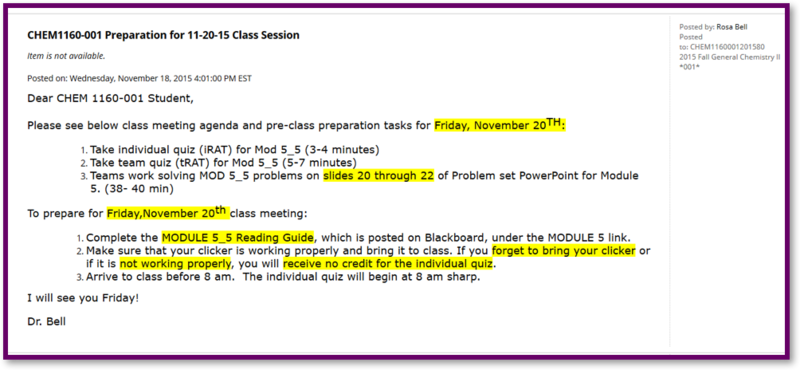
Figure 7: Blackboard announcement illustrating communication with students regarding course expectations.
While the instructional practices listed above are not unique to team-based learning, the implementation of practices such as providing immediate and frequent feedback, incorporating activities that promote self-reflection, and encouraging collaborative work is facilitated in the team-based learning framework. As proposed by the cognitive perspective of the effects small-group learning has on academic achievement (Springer, Stanne & Donovan, 1999), interactions between students increase achievement because they provide more opportunities for information processing. The discussions that take place within each team as well as among different teams expose students to ideas that challenge their assumptions and ways of thinking. When students are confronted with the alternative viewpoints of team members or other teams, they get immediate feedback and are placed in a position in which they have to think critically and elaborate on their views to defend them. By going through this process, students gain a deeper conceptual understanding. The finding that instructional guidance is a significant predictor of students’ learning can be further understood by taking into consideration that, in addition to containing subject-specific terminology, textbooks—particularly in chemistry—often require that readers make inferences to fill conceptual gaps, making comprehension of the course material challenging, even for skilled readers (Zwaan & Singer, 2003). Researchers have suggested that to overcome comprehension difficulties, instructors should help students bridge the gaps between the content presented and text readings (Best, Rowe, Ozuru, & McNamara, 2005).
Concluding Remarks
The team-based learning approach used in this case study provides an environment that encourages collaboration within each learning team and between different teams. Participating in team discussions during the readiness assurance process (i.e., team quizzes) and during problem-solving activities helps students realize that they can achieve higher levels of understanding of the course material through cooperative learning. The more students indicated feeling that the TBL approach was beneficial, the more they likely perceived this pedagogical method as beneficial to their learning needs, thus developing a positive view of the learning environment.
The second most important factor in predicting students’ perceived learning is their view of the instructor’s interest and investment in their learning. An instructor who clearly explains course goals and expectations uses illustrations to explain difficult points, provides immediate and frequent feedback on course assignments and assessments, incorporates activities that promote self-reflection, and encourages collaboration among students, positively relates to students’ perceived learning outcomes.
As indicated by the students, comments below, positive learning outcomes can be enhanced when instructors focus on being facilitators for learning rather than on serving as indubitable experts on the subject matter, concentrate time and energy on providing a learning environment and strategies that allow students to take active roles in the learning process and to be accountable for their own and their peers’ learning.
“……One other strength for this course I believe was Dr. Bell herself, she was so helpful at all times and her positive spirit and attitude made the class great and the material easier to learn.”
“She is a fantastic teacher. She made making an A in a hard course like chemistry actually achievable. One of the best chemistry teachers I have ever had!”
“Dr. Bell is a wonderful professor. She is possibly one of the most caring people I have met. I want her to know that she has inspired me to not only become a better individual and to take risks, but to encourage my colleagues and classmates to do the same. Thank you for everything you have done, Dr. Bell.”
Based on her experience, Dr. Bell invites instructors to give consideration to students’ feelings about the learning environment and the extent of perceived instructional guidance when developing, implementing, and refining team-based learning approaches.
“The TBL approach is definitely one that more professors should use, especially in challenging courses.” Comment from a student.
Learn More
Additional Resources
http://www.teambasedlearning.org/: Team-based Learning Collaborative. This website offers teaching resources and professional development.
https://youtu.be/B4wiDafL8TA: Readiness Assurance Process: The Classroom Experience.
https://youtu.be/KNgvRIpiO9s: Using Readiness Assurance Process in Two Different Situations.
https://info.catme.org/:This website provides tools for assigning students to teams, self and peer evaluations and rating peer processes.
References & Resources
Astin, A. W. (1984). Student involvement: A developmental theory for higher education. Journal of College Student Development, 40, 518-529.
Beatty, S. J., Kelley, K. A., Metzger, A. H., Bellebaum, K. L., & McAuley, J. W. (2009). Team-based learning in therapeutics workshop sessions. American Journal of Pharmaceutical Education, 73 (6), 1-7.
Best, R. M., Rowe, M., Ozuru, Y., & McNamara, D. S. (2005). Deep-level comprehension of science texts: The role of the reader and the text. Topics in Language Disorders, 25 (1), 65-83.
Clark, M. C., Nguyen, H. T., Bray, C., & Levine, R. E. (2008). Team-based learning in an undergraduate nursing course. Journal of Nursing Education, 47 (3), 111-117.
Epstein, M. L. Lazarus, A. D., Calvano, T. B., Matthews, K. A., Hendel, R. A., Epstein, B. B., and Brosvic, G. C. (2002). Immediate Feedback Assessment Technique Promotes Learning and Corrects Inaccurate First Responses. The Psychological Records (52) 187-201.
Fink, L. D. (2002). Beyond small groups: Harnessing the extraordinary power of learning teams. In Michaelsen, L. K., Knight, A. B., & Fink, L. D. (Eds.), Team – based learning: A transformative use of small groups (pp. 3-26). Westport, CT: Greenwood publishing group.
Haidet, P., & Facile, M. L. (2006). Team-based learning: A promising strategy to foster active learning in cancer education. Journal of Cancer Education, 21 (3), 125-128.
Haidet, P., Morgan, R. O., O’Malley, K., Moran, B.J., & Richards, B. F. (2004). A controlled trial of active versus passive learning strategies in a large group setting. Advances in Health Sciences Education, 9 (1), 15-27.
Johnson, D. W., Johnson, R., & Smith, K. A. (2014). Cooperative learning: Improving University instruction by basing practice on validated theory. Journal on Excellence in College Teaching, 25 (3&4), 85-118.
Koles, P. G., Stolfi, A., Borges, N. J., Nelson, S., & Parmelee, D. X. (2010). The impact of team-based learning on medical students’ academic performance. Academic Medicine, 85 (11), 1739-1745.
Michaelsen, L. K., Knight, A. B., & Fink, L. D. (Eds.). (2002). Team – based learning: A transformative use of small groups. Westport, CT: Greenwood publishing group.
Parmelee, D. X., DeStephen, D., & Borges, N. J. (2009). Medical students’ attitudes about team-based learning in a pre-clinical curriculum. Medical Education Online, 14, 1.
Parmelee, D. X., & Michaelsen, L. K. (2010). Twelve tips for doing effective team-based learning (TBL). Medical Teacher, 32 (2), 118-122.
Pekrun, R. (2006). The control-value theory of achievement emotions: Assumptions, corollaries, and implications for educational research and practice. Educational Psychology Review, 18 (4), 315-341.
Pekrun, R., & Perry, R. (2014). Control-value theory of achievement emotions. International Handbook of Emotions in Education, 120-141.
Prince, M. (2004). Does active learning work? A review of the research. Journal of engineering education, 93 (3), 223-231.
Rose, D., & Meyer, A. (2002). Teaching every student in the digital age: universal design for learning. Retrieved from: http://www.cast.org/our-work/publications/2002/universal-design-learning-udl-teaching-every-student-rose.html#.XEN1n81OlPY.
Springer, L., Stanne, M. E., & Donovan, S. S. (1999). Effects of small-group learning on undergraduates in science, mathematics, engineering, and technology: A meta-analysis. Review of Educational Research, 69 (1), 2151.
Thompson, B. M., Schneider, V. F., Haidet, P., Perkowski, L. C., & Richards, B. F. (2007). Factors influencing implementation of team-based learning in health sciences education. Academic Medicine, 82 (10), 53-56.
Zwaan, R. A., & Singer, M. (2003). Text comprehension. In Graesser, A. C., Gernsbacher, M. A., and Goldman, S. R. (Eds.). Handbook of discourse processes (Vol 3, pp. 83-121). New Jersey: Lawrence Erlbaum Associates, Inc.
About the Author
Rosa Alvarez Bell
Rosa Alvarez-Bell is a Teaching Assistant Professor in Chemistry and Coordinator of the General Chemistry Laboratories at East Carolina University (Greenville, NC, USA).
Contributor Authors
Derrick Wirtz is a Senior Instructor in Psychology and Director of Psychological Science Graduate Programs at the University of British Columbia (Kelowna, BC, Canada).
Hui Bian is a Research and Statistics Consultant in the Office for Faculty Excellence at East Carolina University (Greenville, NC, USA)







